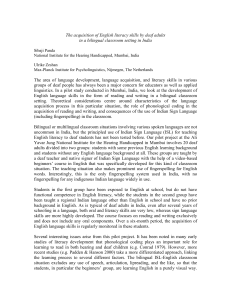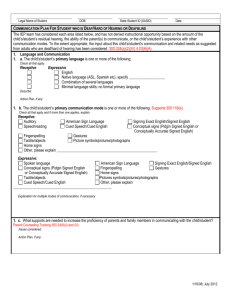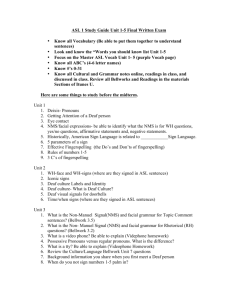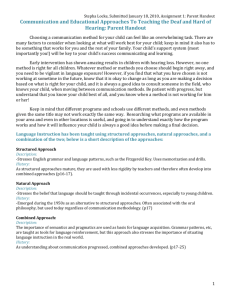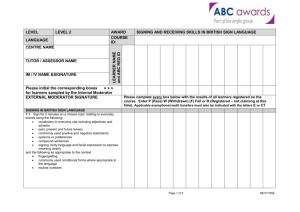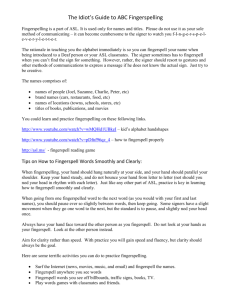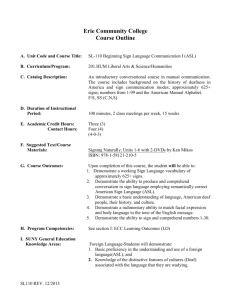the importance of fingerspelling for reading - VL2
advertisement
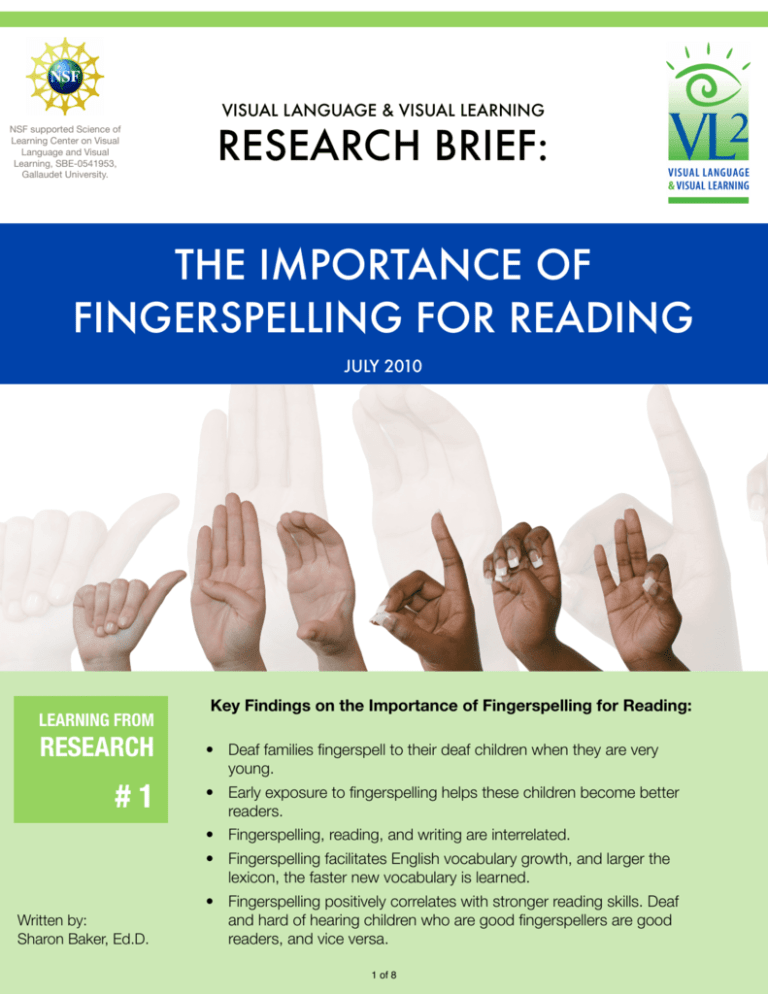
VISUAL LANGUAGE & VISUAL LEARNING NSF supported Science of Learning Center on Visual Language and Visual Learning, SBE-0541953, Gallaudet University. RESEARCH BRIEF: THE IMPORTANCE OF FINGERSPELLING FOR READING JULY 2010 LEARNING FROM RESEARCH #1 Key Findings on the Importance of Fingerspelling for Reading: • Deaf families fingerspell to their deaf children when they are very young. • Early exposure to fingerspelling helps these children become better readers. • Fingerspelling, reading, and writing are interrelated. • Fingerspelling facilitates English vocabulary growth, and larger the lexicon, the faster new vocabulary is learned. Written by: Sharon Baker, Ed.D. • Fingerspelling positively correlates with stronger reading skills. Deaf and hard of hearing children who are good fingerspellers are good readers, and vice versa. 1 of 8 NSF SCIENCE OF LEARNING CENTER ON VISUAL LANGUAGE AND VISUAL LEARNING RESEARCH BRIEF NO. 1: THE IMPORTANCE OF FINGERSPELLING FOR READING Fingerspelling and American Sign Language On the most simplistic level, fingerspelling can be defined as the use of handshapes to represent letters of the alphabet. Indeed, before the complexity of fingerspelling was documented, researchers thought fingerspelling was merely a manual representation of English orthography (print).1 They believed fingerspelling was primarily for representing proper nouns or for English words without a sign equivalent. 2,3 This form of fingerspelling is referred to by Padden as neutral fingerspelling.4 Fingerspelling, though, is complex and integrates American Sign Language (ASL) in systematic ways; it is not just a system to borrow English words.5,6,7 While fingerspelling can be neutral, it can also expand the ASL lexicon (vocabulary) through the use of abbreviations, twoword compounds, initialized signs, fingerspelled compounds, and through the process of lexicalization (see appendices). Fingerspelling and Classroom Instruction Native ASL signers use fingerspelling for 10-15% of their signed discourse, depending on the topic.8 In addition, deaf teachers use over 50% more fingerspelled words than hearing teachers during classroom instruction.9 Padden found that hearing L2 learners of ASL, including classroom teachers, tended to use neutral fingerspelling almost exclusively; as a result, children in these settings often miss the advantages of more advanced forms of fingerspelling.4 Deaf Families, Fingerspelling, and Reading Deaf families fingerspell abundantly when communicating with their young children because t h e y u n d e r s t a n d t h e i m p o r t a n t ro l e t h a t fingerspelling plays in visual learning. At 24 months of age, deaf children with deaf parents have vocabulary sizes that are comparable to that of hearing children who are learning a spoken language.10 Additionally, older deaf and hard of hearing children from deaf families tend to read at higher levels than deaf and hard of hearing children from hearing families. 11 Fingerspelling likely contributes to this success. Unfortunately, young deaf and hard of hearing children from hearing families are not generally given the same early learning opportunity. Indeed, the absence of fingerspelling is particularly evident in preschools for deaf and hard of hearing children. 9 To understand the role of fingerspelling in language acquisition and later literacy, it is important to understand how fingerspelling is naturally acquired by deaf and hard of hearing children with deaf families. When do deaf children acquire fingerspelling? Deaf children of deaf parents can begin to sign as early as eight months. 12 Early attempts at fingerspelling appear around 13 months of age 13,14,15,16,17,18,19 with the first fingerspelled word appearing as young as two years of age.15,17,18 Young deaf children do not pay attention to the execution of each individual handshape in the given fingerspelled word. Instead they perceive fingerspelled words as whole units or signs.20 Akamatsu coined the term movement envelope to describe the movement of the hand while fingerspelling.13 Deaf children's recognition of this movement envelope corresponds with their acquisition of signs. Deaf children in deaf families have also been observed to use sequences of three or four signs at two years of age.12,14,21 This early visual language development in deaf children is similar to early spoken language development in hearing children. The developmental stages and trajectories of fingerspelling have been documented (see appendices). Fingerspelling and Reading Grushkin stated that fingerspelling provides a linguistic link to English vocabulary and syntax.24 Certainly, the importance of fingerspelling in the education of deaf and hard of hearing children has b e e n d o c u m e n t e d i n t h e l i t e r a t u r e . 4,9, 18,19,23,25,26,27,28,29,30,31 One comprehensive study, VL2.GALLAUDET.EDU July 2010 2 of 8 NSF SCIENCE OF LEARNING CENTER ON VISUAL LANGUAGE AND VISUAL LEARNING RESEARCH BRIEF NO. 1: THE IMPORTANCE OF FINGERSPELLING FOR READING conducted by Padden and Ramsey, investigated reading ability and specific language skills of deaf students in third through seventh grade.9 The results revealed that knowledge of specific ASL structures, including fingerspelling, correlates with reading achievement. In this study, children who scored better on reading tests were competent in associative skills, such as the ability to write down words that were fingerspelled to them as well as the ability to translate initialized signs. Looking specifically at performance on the fingerspelling tasks, fingerspelling ability significantly correlated with reading comprehension: “better readers…were better at recognizing fingerspelled words and writing them down in print” (p. 185). Fast Mapping New Vocabulary Several findings have emerged from studies on the relationship of fingerspelling and vocabulary growth. As typically developing children move toward preschool age, they start learning new words on their own.32 This rapid word learning is attributed to fast mapping, which involves cognitive processes whereby new concepts are learned based only on brief exposure to a given unit of information.33 Studies on word-learning abilities in deaf and hard of hearing preschool children indicate that word-learning abilities were related to the size of the children’s expressive vocabulary but not their chronological age. 34,35 Regardless of the communication modality and the hearing status of the parents, performance was strongly related to the number of vocabulary words the children had in their lexicon. That is, it is the size of the vocabulary that makes indirect word learning relatively easy. In another study, students who had higher reading levels performed better at fast mapping fingerspelled words than those students who had lower reading levels.31 Haptonstall-Nykaza & Schick found that students’ retention of new vocabulary increased when lexicalized fingerspelling was added to instruction.36 Furthermore, Hile’s work revealed a strong relationship between fluency in fingerspelling, reading, and vocabulary skills.26 The research is clear that fingerspelling, reading, and writing skills are intertwined and that they converge for deaf children, who have early access to visual language, around the third grade.4 The convergence of these skills facilitates literacy development in deaf and hard of hearing children, allowing them to achieve reading levels that exceed the historically low norms. Integration of Research in Education The VL2 center publishes research briefs as a resource for educators and parents. The goal is to inform the education community of research findings, to summarize relevant scholarship, and, to present recommendations that educators and parents can use when addressing the multifaceted challenges of educating deaf and hard of hearing children. The information provided in this brief is intended to clarify the importance of fingerspelling in the early language development of deaf and hard of hearing children. In addition to the research brief, appendices have been created that provide supplementary information for educators to share with families or to use when integrating fingerspelling into classroom practices. The appendices address: § § § Instructional Strategies for Using Fingerspelling The Developmental Process in Fingerspelling Acquisition Expanding the ASL Lexicon through Fingerspelling Research briefs are available at vl2.gallaudet.edu. To cite this brief: Visual Language and Visual Learning Science of Learning Center. (2010, July). The Importance of Fingerspelling for Reading. (Research Brief No. 1). Washington, DC: Sharon Baker. Credits Writer: Sharon Baker, Ed.D. Editor: Kristen Harmon, Ph.D. Design: Melissa Malzkuhn, M.A. Consultant: Diane Clark, Ph.D. VL2.GALLAUDET.EDU July 2010 3 of 8 NSF SCIENCE OF LEARNING CENTER ON VISUAL LANGUAGE AND VISUAL LEARNING RESEARCH BRIEF NO. 1: THE IMPORTANCE OF FINGERSPELLING FOR READING Appendix A. Instructional Strategies for Using Fingerspelling Instructional Strategies for Using Fingerspelling Deaf teachers use visual strategies for incorporating fingerspelling into classroom instruction. Studies on these visual strategies show that they are a natural part of classroom interaction and are used to promote greater understanding and retention of academic material. Sandwiching The sandwiching technique alternates between fingerspelling and signing. This method also reinforces the equivalency of ASL and English. 1) Fingerspell T-O-R-N-A-D-O; 2) sign TORNADO; and 3) fingerspell T-O-R-N-A-D-O again. Three such instructional strategies for using fingerspelling are as follows: Or: 1) Sign TORNADO; Chaining Chaining is used for introducing new concepts or new vocabulary terms. Chaining creates associations by connecting signs, fingerspelling, and the printed/ written word in a sequence, with one format reinforcing the previous one. Through chaining, the teacher provides multiple ways for the students to learn the word and concept. In addition, teachers may use objects, pictures, or multimedia to reinforce the concepts. For example, when teaching the word, tornado, a teacher might choose one of the following sequences: 1) Point to the word tornado written on the board; 2) fingerspell T-O-R-N-A-D-O; and 3) sign TORNADO. Or: 1) Fingerspell T-O-R-N-A-D-O; 2) sign TORNADO; and 3) write tornado on the board. 2) fingerspell T-O-R-N-A-D-O; and 3) sign TORNADO again. Lexicalized Fingerspelling New signs are created through a process where fingerspelled words are altered or lexicalized to become more sign-like. Commonly referred to as loan signs, these signs sometimes omit letters (#JOB) while others blend the handshapes seamlessly (#BUS). Through this process, a loan sign is formed. Lexicalized fingerspelled signs include nouns, verbs, adjectives, conjunctions, interjections and wh-words. Lexicalized fingerspelling transforms the fingerspelled word into a sign-like visual image. Deaf teachers often use this technique; first, they produce a neutral version of a fingerspelled word, and then follow that with a lexicalized version. This process supports visual memory and facilitates retention. Common Fingerspelled Loan Signs #BANK #BACK #OFF #ON #IF #SALE #EARLY #BUT #BUS #CAR #WHAT #DO #SO #OK #JOB #YES #NO #DOG #TOY #FIX VL2.GALLAUDET.EDU July 2010 4 of 8 NSF SCIENCE OF LEARNING CENTER ON VISUAL LANGUAGE AND VISUAL LEARNING RESEARCH BRIEF NO. 1: THE IMPORTANCE OF FINGERSPELLING FOR READING Appendix B. The Developmental Process in Fingerspelling Acquisition Typically fingerspelling and American Sign Language acquisition occurs simultaneously; however, this chart (see back page) focuses upon approximate developmental trajectories for fingerspelling. Stage One The earliest handshapes produced by deaf and hard of hearing toddlers use the whole hand; more complex handshapes are developed later as dexterity improves. Substitution of visually similar handshapes in the place of more complex ones is common in young children. In addition, transitioning between some letters (e.g. D and R) requires the more advanced motor skills acquired at a later age. When ready for preschool, children exposed to ASL from birth know which vocabulary words to fingerspell, such as names of people, places, and simple proper nouns. Signing children are developmentally ready to understand how fingerspelling represents printed English. It is during this time that children begin to explore the relationship between fingerspelled handshapes and the printed letters. Stage Two The second stage of fingerspelling development focuses on a shift of attention to individual letters when attempting to fingerspell. Deaf children in this stage become aware of individual letters, and this is similar to the development of the alphabetic principle in hearing children. This occurs around four years of age for deaf children of deaf families. The children, though, often have handshape substitutions (5 handshape for W). Stage two continues until approximately third grade for children with early access to visual language, but it can continue until later for children who did not have the advantage of early fingerspelling. Stage Three The third stage of fingerspelling development is when the child has finally mastered neutral fingerspelling, including the appropriate handshapes in the correct sequence with correct movement. In this stage, which occurs around third grade for native signers but can continue to adolescence, there is a convergence of skills or fingerspelling synthesis when the child is able to fingerspell a word, write the word, and understand the word when someone else fingerspells it. That is, reading, writing, and fingerspelling are integrated to the extent that each supports the other. 8-12 months 12-24 months 24-36 months 36-48 months Finger babbles in response to conversations. Uses simple handshapes to form signs, mostly wholehand letters and numbers/ handshapes: B, C, O, A, S, 1 and 5. Uses handshapes of increasing complexity, such as L, G, F, Q, D, Z, Y, I, and J, to form signs. Uses more Begins development handshapes of of the alphabetic increasing complexity, principle by learning such as V, H, W, U, T, that lexicalized signs H, K, P, X, Y, R, E, M, are made of and N to form signs. handshapes. First signs may appear. Perceives fingerspelled Understands simple Uses lexicalized signs words as a whole unit, fingerspelled words (own abundantly, e.g. BUS, known as a movement name, pet’s name, etc.). TV, and NO. envelope. Uses pre-linguistic gestures. Early attempts at fingerspelling, sometimes to self. Uses lexicalized fingerspelling to spell own name and names of others. Begins using lexicalized fingerspelling. VL2.GALLAUDET.EDU July 2010 5 of 8 48+ months NSF SCIENCE OF LEARNING CENTER ON VISUAL LANGUAGE AND VISUAL LEARNING RESEARCH BRIEF NO. 1: THE IMPORTANCE OF FINGERSPELLING FOR READING Appendix C. Expanding the ASL Lexicon Through Fingerspelling A unique feature of American Sign Language is how fingerspelling expands the lexicon. Neutral Fingerspelling Commonly fingerspelled English words, such as proper nouns (e.g., names of people, cities, companies, brand names, and technical terms), are referred to as Neutral Fingerspelling. Hearing L2 learners of ASL, including classroom teachers, tend to only use this type of fingerspelling. Lexicalized Fingerspelling New signs are created through a process where fingerspelled words are altered or lexicalized to become more sign-like. Commonly referred to as loan signs, these signs sometimes omit letters (#JOB) while others blend the handshapes seamlessly (#BUS). Through this process, a loan sign is formed. Lexicalized fingerspelled signs include nouns, verbs, adjectives, conjunctions, interjections and wh-words. Abbreviations ASL integrates abbreviations or shortened words. Examples of abbreviated signs are “A-P-T” for apartment and “R-E-F” for refrigerator. Interestingly, some state abbreviations that were lexicalized in the past (e.g., OKLA for Oklahoma) are still used instead of the two-letter abbreviations. Two-Word Compounds Two-word compounds in English can be represented through the use of an ASL sign that incorporates the handshapes corresponding to the first letters of the English words, such as in BOARD OF TRUSTEES and SOCIAL-WORK. Initialized Signs An initialized sign uses the handshape that corresponds to the first letter of a written word (e.g., UNIVERSITY). Some common initialized signs are items in a category, such as colors. Another commonly initialized group of words are those words associated with a concept or cluster, such as GROUP, CLASS, FAMILY; these share the same location and movement, but the initialized handshape varies. Signed-fingerspelled Compounds Signed-fingerspelled compounds are another example of how fingerspelling is integrated into ASL. With this category, usually the first segment of a compound is signed while the second segment is fingerspelled (e.g., BLACK+M-A-I-L). VL2.GALLAUDET.EDU July 2010 6 of 8 NSF SCIENCE OF LEARNING CENTER ON VISUAL LANGUAGE AND VISUAL LEARNING RESEARCH BRIEF NO. 1: THE IMPORTANCE OF FINGERSPELLING FOR READING References 2. Battison, R. (1978). Lexical borrowing in American Sign Language. Silver Spring, MD: Linstok Press. 16. Erting, C. J., Thumann-Prezioso, C. & Benedict, B. (2000). Bilingualism in a deaf family: Fingerspelling in early childhood. In P. E. Spencer, C. J. Erting, and M. Marschark (Eds.), The deaf child in the family and at school: Essays in honor of Kathryn P. Meadow-Orlans (pp. 41-54). Mahwah, NJ: Lawrence Erlbaum. 3. Wilcox, S. (1992). The phonetics of fingerspelling. Philadelphia: John Benjamins. 17. Maxwell, M. M. (1988). The alphabetic principle and fingerspelling. Sign Language Studies, 61, 377-404. 4. Padden, C. (2006). Learning to fingerspell twice: Young signing children’s acquisition of fingerspelling. In B. Schick, M. Marschark, & P. E. Spencer (Eds.), Advances in the sign language development of deaf children (pp. 189-201). New York: Oxford University Press. 18.Padden, C. (1991). The acquisition of fingerspelling by deaf children. In P. Siple & S. Fischer (Eds.), Theoretical issues in sign language research, Volume 2: Psychology (pp. 193-210). Chicago: University of Chicago Press. 1. Klima, E. S., & Bellugi, U. (1979). The signs of language. Cambridge: Harvard University Press. 5. Brennan, M. (2001). Making borrowing work in British Sign Language. In D. Brentari (Ed.), Foreign vocabulary in sign language: A cross-linguistic investigation of word formation (pp. 49-85). Mahwah, NJ: Lawrence Erlbaum. 6. Brentari, D., & C. Padden. (2001). Native and foreign vocabulary in American Sign Language: A lexicon with multiple origins. In D. Brentari (Ed.), Foreign vocabulary in sign language: A cross-linguistic investigation of word formation (pp. 86-119). Mahwah, NJ: Lawrence Erlbaum. 7. Padden, C. (1998). The ASL lexicon. Sign Language & Linguistics, 1, 39-60. 8. Padden, C., & Gunsauls, D. C. (2003). How the alphabet came to be used in a sign language. Sign Language Studies, 4, 10-33. 9. Padden, C., & Ramsey, C. (2000). American Sign Language and reading ability in deaf children. In C. Chamberlain, J. P. Morford & R. I. Mayberry (Eds.), Language acquisition by eye (pp. 165-189). Mahwah, NJ: Lawrence Erlbaum. 10. Anderson, D. (2006). Lexical development of deaf children acquiring signed languages. In B. Schick, M. Marschark, & P. E. Spencer (Eds.), Advances in the sign language development of deaf children (pp. 135-160). New York: Oxford University Press. 11. Goldin-Meadow, S., & Mayberry, R. (2001). How do profoundly deaf children learn to read? Learning Disabilities Research and Practice, 16, 222-229. 12. Petitto, L. A. (1983). From gesture to symbol: The relationship between form and meaning in the acquisition of personal pronouns in American Sign Language. Papers and Reports on Child Development, 22, 100-107. 13. Akamatsu, C. T. (1982). The acquisition of fingerspelling in pre-school children. (Unpublished doctoral dissertation). University of Rochester, Rochester. 14. Anderson, D., & Reilly, J. S. (2002). The MacArthur communicative development inventory: Normative data for American Sign Language. Journal of Deaf Studies and Deaf Education, 7, 83–106. 15. Blumenthal-Kelly, A. (1995). Fingerspelling interaction: A set of deaf parents and their deaf daughter. In C. Lucas (Ed.), Sociolinguistics in deaf communities (pp. 62-73). Washington, DC: Gallaudet University Press. 19. Padden, C., & LeMaster, B. (1985). An alphabet on hand: The acquisition of fingerspelling in deaf children. Sign Language Studies, 47, 161-172. 20. Andrews, J., Leigh, I., & Weiner, M. (2004). Deaf people: Evolving perspectives from psychology, education, and sociology. Boston: Allyn & Bacon. 21. Schick, B. (2002). The expression of grammatical relations in deaf toddlers learning ASL. In G. Morgan & B. Woll (Eds.), Directions in sign language acquisition (pp. 143-158). Amsterdam, The Netherlands: John Benjamins Publishing Co. 22. Evans, C., Zimmer, K., & Murray, D. (1994). Discovery with words and signs: A resource guide for developing a bilingual and bicultural preschool programs for deaf and hard of hearing children. Winnipeg, Manitoba, Canada: Sign Talk Development Project. 23.Mayberry, R. I., & Waters, G. S. (1991). Children’s memory for sign and fingerspelling in relation to production rate and sign language input. In P. Siple & D. Fischer (Eds.), Theoretical issues in sign language research, Volume 2: Psychology (pp. 211-229). Chicago: The University of Chicago Press. 24.Grushkin, D. A. (1998). Lexidactylophobia: The irrational fear of fingerspelling. American Annals of the Deaf, 143, 404-415. 25. Hanson, V., Liberman, I., & Shankweiler, D. (1984). Linguistic coding by deaf children in relation to beginning reading success. Journal of Experimental Child Psychology, 37(2), 378-393. 26. Hile, A. (2009). Deaf children's acquisition of novel fingerspelled words. (Unpublished doctoral dissertation). University of Colorado, Boulder. 27. Hirsh-Pasek, K. (1982). What second-generation deaf students bring to the reading task: Another case for metalinguistics and reading. (ERIC Document Reproduction Service No. ED 246 562). 28. Locke, J. L., & Locke, V. L. (1971). Deaf children’s phonetic visual and dactylic coding in a grapheme recall task. Journal of Experimental Psychology, 89(1), 142-146. 29. Puente, A., Alvarado, J., & Herrera, V. (2006). Fingerspelling and sign language as alternative codes for reading and writing words for Chilean deaf signers. American Annals of the Deaf, 151(3), 299-310. VL2.GALLAUDET.EDU July 2010 7 of 8 NSF SCIENCE OF LEARNING CENTER ON VISUAL LANGUAGE AND VISUAL LEARNING RESEARCH BRIEF NO. 1: THE IMPORTANCE OF FINGERSPELLING FOR READING 30. Treiman, R., & Hirsh-Pasek, K. (1983). Silent reading: Insights from second-generation deaf readers. Cognitive Psychology, 15(1), 39-65. 31. Sedey, A. L. (1995). Fast mapping of novel fingerspelled words by profoundly deaf students. (Unpublished doctoral dissertation). University of Wisconsin, Madison. 32. Meyerhoff, M. K. (2008). Fast mapping and syntactic bootstrapping. Pediatrics for Parents, 24, 8-10. 33. Carey, S., & Bartlett, E. (1978). Acquiring a single new word. Papers and Reports on Child Language Development, 15, 17-29. 34. Lederberg, A. R., Prezbindowski, A. K., & Spencer, P. E. (2000). Word-learning skills of deaf preschoolers: The development of novel mapping and rapid word-learning strategies. Child Development, 71(6), 1571-1585. 35. Lederberg, A. R., & Spencer, P. E. (2008). Word-learning abilities in deaf and hard-of-hearing preschoolers: Effect of lexicon size and language modality. Journal of Deaf Studies and Deaf Education, Advance Access published May 20, 2008 doi:10.1093/deafed/enn021 36. Haptonstall-Nykaza, T. S., & Schick, B. (2007). The transition from fingerspelling to English print: Facilitating English decoding. Journal of Deaf Studies and Deaf Education 12(2), 172-183.24. Fingerspelling and sign language as alternative codes for reading and writing words for Chilean deaf signers. American Annals of the Deaf, 151(3), 299-310. References (Appendix A) Blumenthal-Kelly, A. (1995). Fingerspelling interaction: A set of deaf parents and their deaf daughter. In C. Lucas (Ed.), Sociolinguistics in deaf communities (pp. 62-73). Washington, DC: Gallaudet University Press. Haptonstall-Nykaza, T. S., & Schick, B., (2007). The transition from fingerspelling to English print: Facilitating English decoding. Journal of Deaf Studies and Deaf Education 12,172-183. Hile, A. (2009). Deaf children's acquisition of novel fingerspelled words. Unpublished dissertation. University of ColoradoBoulder. Humphries, T., & MacDougall, F. (1999). Chaining and other links: Making connections between American Sign Language and English in two types of school settings. Visual Anthropology Review, 15, 84-94. Padden, C., & Ramsey, C. (1998). Reading ability in signing deaf children. Topics in Language Disorders, 18, 30-46. Valli, C. & Lucas, C. (1992). Linguistics of American Sign Language. Washington, DC: Gallaudet University Press. Boyes-Braem, P. (1990). Acquisition of the handshape in American Sign Language: A preliminary analysis. In V. Volterra & C. Erting (Eds.), From gesture to language in hearing and deaf children (pp. 107-127). Washington, DC: Gallaudet University Press. Easterbrooks, S. & Baker, S. (2002). Language learning in children who are deaf and hard of hearing: Multiple pathways. Allyn & Bacon, Boston. Mayberry, R., & Waters, G. (1991). Children’s memory for sign and fingerspelling in relation to production rate and sign language input. In P. Siple & D. Fischer (Eds.), Theoretical issues in sign language research (pp. 211-229). Chicago: University of Chicago Press. Padden, C. (2006). Learning to fingerspell twice: Young signing children’s acquisition of fingerspelling. In B. Schick, M. Marschark & P. Spencer (Eds.), Advances in the sign language development of deaf and hard-of-hearing Children (pp. 189-201). New York: Oxford University Press. References (Appendix C) Battison, R. (1978). Lexical borrowing in American Sign Language. Silver Spring, MD: Linstok Press. Blumenthal-Kelly, A. (1995). Fingerspelling interaction: A set of deaf parents and their deaf daughter. In C. Lucas (Ed.), Sociolinguistics in deaf communities (pp. 62-73). Washington, DC: Gallaudet University Press. Brentari, D., & Padden, C. (2001). Native and foreign vocabulary in American Sign Language: A lexicon with multiple origins. In D. Brentari (Ed.), Foreign vocabulary in sign language: A cross-linguistic investigation of word formation (pp. 86-119). Mahwah, NJ: Lawrence Erlbaum. Padden, C. (1991). The acquisition of fingerspelling by deaf children. In P. Siple & S. Fischer (Eds.), Theoretical issues in sign language research, (pp. 193-210). Chicago: University of Chicago Press. Padden, C. (1998). The ASL lexicon. Sign language and linguistics, 1, 39-60. Padden, C. (2006). Learning to fingerspell twice: Young signing children’s acquisition of fingerspelling. In B. Schick, M. Marschark & P. Spencer (Eds.), Advances in the sign language development of deaf children (pp. 189-201). New York: Oxford University Press. Padden, C., & Gunsauls, D. C. (2003). How the alphabet came to be used in sign language. Sign Language Studies, 4, 10-33. References (Appendix B) ASL Development Checklist, Evans & Zimmer, 1994 revised. ASL Developmental Milestones, Canadian Cultural Society of the Deaf and the Ontario Society of the Deaf, 2003. ASL Development Observation Record, California School for the Deaf-Fremont. VL2.GALLAUDET.EDU July 2010 8 of 8

